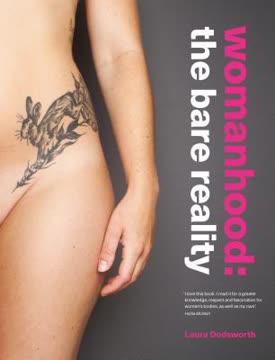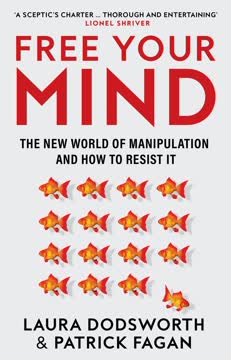Key Takeaways
1. Reclaiming the Narrative: Naming and Owning the Female Body
So many women avoid naming their ‘bits’ at all.
Language shapes perception. The author highlights the lack of established, positive vocabulary for female genitalia, noting that existing terms are often "under-whelming and devaluing." This absence of empowering language contributes to women's disconnection from their own bodies.
Breaking the silence. The book aims to challenge this silence by encouraging women to use accurate and respectful terms like "vulva" and "vagina," fostering a sense of ownership and control over their own anatomy. This act of naming is a crucial step in reclaiming the narrative surrounding the female body.
Personal and political. By giving voice to women's experiences, the book seeks to dismantle the shame and stigma associated with female anatomy, paving the way for a more open and honest dialogue about women's health, sexuality, and overall well-being. This reclamation of language is not just a personal act, but a political one, challenging societal norms and empowering women to define themselves on their own terms.
2. Beyond the Male Gaze: Women Seeing Themselves
For some women it was the very first time they had seen their vulva.
Intimacy with self. The author notes that many women had never truly seen their own vulvas before participating in the project, highlighting a profound disconnect between women and their own bodies. This lack of self-awareness is often perpetuated by societal emphasis on the male gaze.
Challenging the ideal. The book's photographs aim to disrupt the "tidy pussy of porn" ideal, showcasing the diversity and beauty of real vulvas and encouraging women to feel comfortable and proud in their own skin. This visual representation of female anatomy is a powerful tool for self-acceptance and body positivity.
Shifting the focus. By encouraging women to see their vulvas as living body parts, isolated from any sexual or birthing context, the book empowers them to occupy their bodies from a place of pleasure, not an anxious imagining through a lover's eyes. This shift in perspective is crucial for fostering self-love and sexual empowerment.
3. The Complex Tapestry of Female Experience: Trauma, Pleasure, and Everything In Between
Talking about vulvas and vaginas grants access to our deepest shame, our fiercest pleasure, our most intimate moments and the most terrible traumas.
A spectrum of experiences. The book delves into the full spectrum of female experience, from pleasure and joy to pain and trauma, acknowledging that women's lives are never singular. This holistic approach challenges simplistic narratives and celebrates the complexity of womanhood.
Unveiling hidden realities. The author notes being stunned by the multiple stories of childhood grooming, sexual abuse, assault, rape, and medical and birth trauma woven into the tapestry of women's lives. This revelation underscores the pervasive nature of injustice and the need for greater awareness and support.
Finding strength in rage. The author emphasizes the importance of tapping into the "reservoir of rage" provoked by these stories, recognizing it as a source of "quiet, deep, warrior-like strength" that can empower women to assert their opinions, set boundaries, and stand in solidarity with one another.
4. Sisterhood and Solidarity: Finding Strength in Shared Stories
When you read this sisterhood of stories and witness these women’s tender parts laid bare, I hope you find compassion and understanding for them and sense their power.
Breaking isolation. The book aims to combat the separation and isolation of modern life by creating a "sisterhood of stories" that offer help and understanding. This communal reservoir of shared experiences fosters a sense of connection and belonging.
Witnessing and validation. By witnessing these women's tender parts laid bare, readers are invited to find compassion and understanding for them, and to sense their power. This act of witnessing validates the experiences of women and challenges the societal forces that seek to silence them.
Empowerment through connection. The author hopes that readers will find compassion and understanding for themselves and find their own power through this sisterhood of stories. This emphasis on self-compassion and empowerment is a key element of the book's transformative potential.
5. The Evolving Relationship with Sexuality: From Shame to Empowerment
It takes women so long to let go of embarrassment and shame that’s ingrained in us.
Challenging ingrained shame. The book acknowledges the long and difficult journey women face in letting go of the embarrassment and shame that is ingrained in them by society. This process of unlearning is essential for reclaiming sexual agency and pleasure.
Reclaiming pleasure. The author expresses anger that women's pleasure is often put aside in favor of their partners, and that women are often taught to perform sex rather than experience it. This critique highlights the need for women to prioritize their own pleasure and desires.
Celebrating sensual delight. The book celebrates the potential women have for pleasure, sensual delight, and "hot filthy sex," and admires women who have cast shame and inhibition aside. This celebration of female sexuality is a powerful antidote to the societal forces that seek to suppress it.
6. Motherhood: Power, Pain, and Redefining Womanhood
Birth may be everyday, but it’s epic.
The primal human experience. The author emphasizes the profound and transformative nature of birth, recognizing it as the "ultimate primal human experience" that connects all of humanity. This perspective elevates birth beyond the mundane and celebrates its epic scale.
Beyond biological capabilities. The book acknowledges the challenges women face when reproductive health problems threaten their ability to conceive, and encourages them to re-evaluate what womanhood can look like outside of their biological capabilities. This redefinition of womanhood is crucial for fostering self-acceptance and resilience.
Shame and celebration. The author notes the strange way that women's bodies can do all these powerful things but they're shrouded in shame. This paradox highlights the need to celebrate female reproductive biology and challenge the societal forces that seek to diminish it.
7. Aging and Womanhood: Embracing Change and Rejecting Societal Limits
The aging process is interesting because people talk about your body going south and they mean your breasts, face and tummy, but of course your vulva goes south too.
Beyond youthful beauty. The book challenges the societal obsession with youthful beauty, acknowledging that the aging process affects all parts of the body, including the vulva. This perspective encourages women to embrace the changes that come with age and reject the pressure to conform to unrealistic ideals.
Continued desire and pleasure. The author emphasizes that the end of menstruation does not mean the end of desire or pleasure, and celebrates the experiences of older post-menopausal women. This perspective challenges the societal notion that women become sexually irrelevant after a certain age.
Reclaiming power and juiciness. The author notes that she is approaching perimenopause, yet feels freer, happier, more sexually potent, and more in her prime than ever before. This personal transformation serves as an inspiration for women to reject societal limits and embrace their own power and juiciness at any age.
8. Reproductive Health: Advocacy, Awareness, and Breaking the Silence
I was sure a man would think it felt like I had a penis or really saggy lips.
Challenging medical bias. The book highlights the stories of women who have been dismissed or mistreated by medical professionals, particularly in regards to gynecological conditions and birth trauma. This critique underscores the need for greater empathy and understanding in healthcare.
Advocating for change. The author shares her experience of setting up a charity to address reproductive health issues in the BAME community, highlighting the importance of culturally sensitive and accessible healthcare. This advocacy work seeks to break the silence and stigma surrounding women's health.
Empowering women with knowledge. The book emphasizes the importance of women understanding their own bodies and advocating for their own health. This empowerment through knowledge is crucial for navigating the often-complex and challenging world of reproductive healthcare.
9. The Impact of Societal Expectations: Body Image, Virginity, and Sexual Performance
When I was in my 20s, I thought no one would want to give me oral sex because I had so much pubic hair.
Challenging beauty standards. The book explores the ways in which societal beauty standards, particularly those perpetuated by porn, can negatively impact women's body image and self-esteem. This critique encourages women to reject unrealistic ideals and embrace their own unique beauty.
Deconstructing virginity. The book challenges the societal obsession with virginity, recognizing it as a construct that often places undue pressure and shame on women. This perspective encourages women to define their own sexuality on their own terms.
Rejecting performance. The book critiques the pressure women face to perform sexually, both for their partners and for the male gaze. This critique encourages women to prioritize their own pleasure and desires, and to reject the notion that they must be sexually pleasing to be valuable.
10. Redefining Womanhood: Beyond Biology, Embracing Individuality
Ultimately I want to live in a world where we are people and not defined by what’s between our legs.
Beyond genitalia. The book challenges the notion that womanhood is solely defined by biology, recognizing that gender is a social construct and that there are many ways to be a woman. This perspective encourages readers to embrace their own unique identities and reject limiting stereotypes.
Finding balance. The author shares her personal journey of finding balance within herself, recognizing that this is where she is finding her healing. This emphasis on self-discovery and personal growth is a key element of the book's transformative potential.
Reclaiming womanhood. The book concludes with a call to action, urging readers to reclaim their womanhood on their own terms, in their own words, and in their own image. This empowering message encourages women to define themselves and their experiences, rather than allowing society to do it for them.
Last updated:
FAQ
1. What is Womanhood: The Bare Reality by Laura Dodsworth about?
- Exploration of female experience: The book is a radical inquiry into womanhood, featuring intimate photographs and stories from 100 women about their vulvas and vaginas.
- Breaking silence and shame: It addresses the silence and shame surrounding female anatomy, challenging societal taboos and medical ignorance.
- Personal and societal impact: Through candid interviews and images, it reveals the complex realities of womanhood, including pleasure, trauma, motherhood, and identity.
- Celebration and empowerment: The project aims to reclaim womanhood on women’s own terms, fostering understanding, respect, and solidarity.
2. Why should I read Womanhood: The Bare Reality by Laura Dodsworth?
- Unique intimate perspectives: The book offers unprecedented access to women’s personal stories and unaltered photographs, providing an honest look at female anatomy and experience.
- Educational and empowering: It educates about the lack of scientific and societal understanding of female bodies, encouraging body positivity and autonomy.
- Emotional resonance and solidarity: Readers encounter stories of trauma, resilience, and empowerment, fostering empathy and open conversations about taboo topics.
- Challenges stereotypes: The book breaks down myths and misconceptions, promoting a more inclusive and realistic view of womanhood.
3. What are the key themes and takeaways from Womanhood: The Bare Reality by Laura Dodsworth?
- Visibility and diversity: The book celebrates the diversity of vulvas and vaginas, challenging narrow beauty standards and promoting body confidence.
- Silence and shame: It highlights how societal silence leads to ignorance, shame, and lack of control over women’s bodies.
- Pleasure, trauma, and healing: Women’s stories reveal the coexistence of pleasure and pain, advocating for compassion and informed approaches to women’s sexuality.
- Empowerment and solidarity: The project fosters a sense of community and collective healing among women.
4. How does Laura Dodsworth approach the methodology in Womanhood: The Bare Reality?
- Photographic intimacy: Dodsworth photographed 100 women’s vulvas and vaginas in a safe, respectful environment, focusing on authenticity and non-sexualized representation.
- Storytelling as midwifery: She acted as a “midwife” for women’s stories, creating space for honest, vulnerable sharing through in-depth interviews.
- Anonymity and consent: Participants’ stories are shared anonymously, with informed consent and ethical considerations prioritized throughout the project.
- Diverse representation: The project includes women of varied ages, backgrounds, and identities to reflect the broad spectrum of womanhood.
5. What kinds of personal experiences do women share in Womanhood: The Bare Reality by Laura Dodsworth?
- Body image and shame: Many women discuss struggles with body image, internalized shame, and learning to appreciate their uniqueness.
- Sexual pleasure and challenges: Stories include discovering orgasms, navigating sexual relationships, and overcoming difficulties with pleasure or communication.
- Trauma and resilience: Experiences of sexual abuse, birth trauma, medical neglect, and FGM are shared, along with journeys of healing and reclaiming power.
- Motherhood and aging: Women reflect on changes through childbirth, menopause, and aging, highlighting evolving relationships with their bodies.
6. How does Womanhood: The Bare Reality by Laura Dodsworth address female pleasure and orgasm?
- Clitoral importance: The book emphasizes the clitoris as a complex organ central to female pleasure, challenging misconceptions and ignorance.
- Varied orgasm experiences: Women describe different types of orgasms—clitoral, vaginal, blended, and even orgasmic birth—highlighting diversity in sexual experience.
- Sexual empowerment: Narratives focus on learning to say “no,” exploring desires, and rejecting societal shame or pressure to fake pleasure.
- Partner dynamics: The impact of partners’ understanding and respect on women’s sexual satisfaction is explored through personal stories.
7. What insights does Womanhood: The Bare Reality by Laura Dodsworth provide about trauma and its impact on women’s sexuality?
- Long-lasting effects: Sexual abuse, rape, and medical trauma are shown to deeply affect women’s relationships with their bodies and sexuality.
- Healing journeys: Recovery often involves therapy, supportive partners, and women-only spaces, with many women describing resilience and empowerment.
- Complex emotions: Feelings of shame, self-blame, and fear are common, but many women also share stories of reclaiming control and finding community.
- Physical manifestations: Trauma can result in pain, vaginismus, and panic attacks during sex, illustrating the mind-body connection.
8. How does Womanhood: The Bare Reality by Laura Dodsworth explore the diversity of womanhood, including trans and non-binary experiences?
- Trans women’s stories: The book includes narratives from trans women about gender confirmation surgery, identity, and claiming womanhood.
- Non-binary perspectives: Some participants identify as non-binary, sharing experiences of gender fluidity and the complexity of identity.
- Intersectionality: The project reflects on how race, culture, sexual orientation, and disability intersect with womanhood, including rare conditions like MRKH syndrome.
- Respect and language: Emphasis is placed on respecting pronouns and avoiding reductive definitions of sex and gender.
9. What cultural and social issues related to womanhood are discussed in Womanhood: The Bare Reality by Laura Dodsworth?
- Female Genital Mutilation (FGM): The book features firsthand accounts of FGM, highlighting its pain, cultural pressures, and lifelong impact.
- Pornography and objectification: Many women critique porn’s unrealistic and degrading portrayals of female bodies and sexuality.
- Sexism and harassment: The influence of the male gaze, casual sexism, and harassment on women’s self-image and experiences is explored.
- Women’s solidarity: The importance of support networks and sexual solidarity among women is emphasized as a source of strength.
10. How does Womanhood: The Bare Reality by Laura Dodsworth address medical and scientific knowledge about female anatomy?
- Limited scientific understanding: The book points out the lack of research on the vagina, clitoris, and pelvic floor, contributing to medical neglect.
- Medical practices and controversies: It discusses labiaplasty, “vaginal rejuvenation,” and FGM as responses to unrealistic ideals or cultural violence.
- Empowerment through knowledge: Sharing stories and images increases awareness, encouraging women to seek informed medical advice and question harmful practices.
- Critique of dismissiveness: The book highlights how conditions like endometriosis are often dismissed, calling for better medical care for women.
11. What role does language and naming play in Womanhood: The Bare Reality by Laura Dodsworth?
- Importance of correct terms: The book advocates for using accurate terms like “vulva” and “vagina,” critiquing euphemisms and the lack of empowering language.
- Breaking taboos: Many women describe avoiding naming their genitals due to embarrassment; the book normalizes open, respectful language.
- Reclaiming words: Some women reclaim words like “cunt” as positive, exploring how language can both oppress and liberate.
- Naming as empowerment: The act of naming is linked to control, autonomy, and the ability to challenge societal taboos.
12. What are the most memorable quotes from Womanhood: The Bare Reality by Laura Dodsworth and what do they mean?
- “What you cannot name, you can’t control.” Highlights the power of language in reclaiming autonomy over female bodies.
- “There is no normal and there is no deviant: there are just women, each one with a story of what her body means.” Celebrates diversity and rejects narrow beauty standards.
- “Being a woman is about power. Power, power, power. Witchy fucking power.” Emphasizes reclaiming female sexuality and identity as sources of strength.
- “FGM is an attempt to control a woman’s sexuality.” Exposes cultural violence and the need for bodily autonomy.
- “My vagina is the most powerful, important, divine part of my body.” Affirms the sacredness and centrality of female sexuality and embodiment.
Review Summary
Womanhood receives overwhelmingly positive reviews, with readers praising its honesty, diversity, and emotional impact. Many found the book empowering, educational, and thought-provoking. Readers appreciated the diverse range of women's stories and perspectives on their bodies and sexuality. Some were moved to tears by the powerful narratives. The book's explicit yet sensitive approach to discussing and depicting women's bodies was widely commended. A few critiques mentioned a lack of disability representation and one review noted potential transphobic content.
Download PDF
Download EPUB
.epub digital book format is ideal for reading ebooks on phones, tablets, and e-readers.







